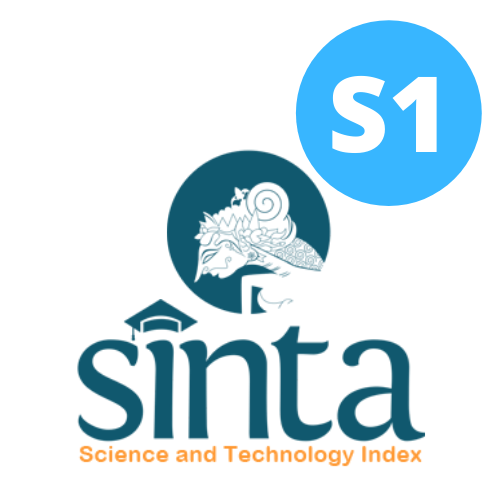Evaluation of the Use of Child Length Mat as A Stunting Early Detection Tool on Children Under Two in Kulon Progo Regency, Yogyakarta
Evaluasi Penggunaan Tikar Pertumbuhan Sebagai Alat Deteksi Dini Kejadian Stunting pada Baduta di Kabupaten Kulon Progo, Yogyakarta

Downloads
Background: Stunting prevention leads to the initiation of child length mats as an early detection tool and the assignment of human development workers as community initiators. There are differences in policy implementation regarding these innovations, particularly in the use of length mats.
Objectives: To evaluate the use of a length mat as a stunting early detection tool on children under two in Kulon Progo Regency.
Methods: A qualitative research with a case study approach was conducted in two stunting locus villages in Kulon Progo Regency. Data were collected using key informant in-depth interviews, document analysis, and reflective journals. Respondents were recruited using the maximum variation sampling technique, and data were analyzed using thematic analysis in accordance with the theory of diffusion of innovation.
Results: Stakeholder acceptance of the length mat was relatively poor. Factors that influenced its adoption in Kulon Progo regency include the pre-existing situation (lack of accurate instruments to measure child length), the easy use of the length mat, and prescribed training. Whereas, factors affecting its rejection include issues related to its relative advantage and validity. This refusal was caused by suboptimal campaigns and a lack of support from the local government. However, the length mat remains in use following its function as a prerequisite for the village fund disbursement.
Conclusions: Suboptimal use of the communication channel to introduce the length mat and lack of support from the local government caused the innovation to fail to diffuse at the district level. Hence, strengthening the campaign and inter-stakeholder communication is necessary to improve acceptance and adherence.
Badan Kebijakan Pembangunan Kesehatan. Laporan Tematik Survei Kesehatan Indonesia (SKI) Tahun 2023: Potret Indonesia Sehat. (Kementerian Kesehatan RI, Jakarta, 2024).
Sekretariat Wakil Presiden Republik Indonesia. Strategi Nasional Percepatan Pencegahan Anak Kerdil (Stunting) Periode 2018-2024. (Sekretariat Wakil Presiden Republik Indonesia, Jakarta, 2018).
Jokhu, L.A. & Syauqy, A. Determinants of concurrent wasting and stunting among children 6 to 23 mo in Indonesia. Nutrition 122, 112390 (2024) https://doi.org/10.1016/j.nut.2024.112390.
Victora, C.G., De Onis, M., Hallal, P.C., Blössner, M. & Shrimpton, R. Worldwide timing of growth faltering: Revisiting implications for interventions. Pediatrics 125, 473-480 (2010) https://doi.org/10.1542/peds.2009-1519.
Asmare, B., Taddele, M., Berihun, S. & Wagnew, F. Nutritional status and correlation with academic performance among primary school children, northwest Ethiopia. BMC Research Notes 11, 805 (2018) https://doi.org/10.1186/s13104-018-3909-1.
Mustakim, M.R.D., Irwanto, Irawan, R., Irmawati, M. & Setyoboedi, B. Impact of Stunting on Development of Children between 1-3 Years of Age. Ethiop J Health Sci 32, 569-578 (2022) 10.4314/ejhs.v32i3.13.
Kementerian Desa Pembangunan Daerah Tertinggal dan Transmigrasi. Buku Saku Kader Pembangunan Manusia (KPM): Memastikan Konvergensi Penanganan Stunting Desa. (2018).
Rahmawati, L.A., Kusuma, M.T.P.L. & Helmyati, S. Persepsi Kader dan Ahli Gizi terhadap Penggunaan Tikar Pertumbuhan sebagai Deteksi Dini Kejadian Stunting pada Balita. (Universitas Gadjah Mada, 2020).
Pemerintah Kabupaten Kulon Progo. Surat Edaran No. 440/4323 tentang Pengukuran Antropometri (Panjang Badan dan Tinggi Badan) pada Balita di Posyandu Kabupaten Kulon Progo. (2020).
Kementerian Kesehatan Republik Indonesia. Buku Saku Hasil Studi Status Gizi Indonesia (SSGI) Tingkat Nasional, Provinsi, dan Kabupaten/Kota Tahun 2021. (Kementerian Kesehatan Republik Indonesia, Jakarta, 2021).
Kementerian Kesehatan Republik Indonesia. Buku Saku Hasil Survei Status Gizi Indonesia (SSGI) 2022. (Kementerian Kesehatan RI, Jakarta, 2022).
Everett, M.R. Diffusion of Innovations, (The Free Press, 1983).
Srivastava, P. & Hopwood, N. A Practical Iterative Framework for Qualitative Data Analysis. International Journal of Qualitative Methods 8, 76-84 (2009) https://doi.org/10.1177/16094069090080010.
Bachtiar, S.B. Meyakinkan Validitas Data Melalui Triangulasi Pada Penelitian Kualitatif. Teknologi Pendidikan (2010).
Badan Penelitian dan Pengembangan Kesehatan. Laporan Provinsi DI Yogyakarta Riskesdas 2018. (Lembaga Penerbit Badan Penelitian dan Pengembangan Kesehatan, Jakarta, 2019).
Kementerian Kesehatan Republik Indonesia. Laporan Akhir Penelitian Studi Status Gizi Balita di Indonesia. (2019).
Bappenas. Pedoman Pelaksanaan Intervensi Penurunan Stunting Terintegrasi Di Kabupaten/Kota. (Jakarta. , 2018).
The Manoff Group. Child Length Mat: A Community Tool To Prevent Stunting. (2018).
Direktorat Jenderal Pembangunan Desa dan Perdesaan. Tikar Pertumbuhan: Inovasi Cegah Stunting dari Desa untuk Indonesia. (Jakarta, 2019).
Save The Children International. NOURISH Project Case Study The Child Length Mat: A Community Tool for Visualizing Linear Growth. (2019).
Wigati M, et al. Anthropometric Kit Development for Stunted Early Detection among Children Under Two Years Old: Providing a Portable Body Length Measurer. Open Access Maced J Med Sci 10(E), 852-859 (2022) https://doi.org/10.3889/oamjms.2022.8952.
Bukari, N., et al. Comparative study of stunting measurement in children using WHO procedure and Growth Length Mat in Ghana. BMC Research Notes 15(2022) https://doi.org/10.1186/s13104-022-06259-x.
Miranda, M.Q., Farias, J.S., de Araújo Schwartz, C. & de Almeida, J.P.L. Technology adoption in diffusion of innovations perspective: introduction of an ERP system in a non-profit organization. RAI Revista de Administração e Inovação 13, 48-57 (2016) https://doi.org/10.1016/j.rai.2016.02.002.
Thapa, S.B. & Gandhi, A. Exploring telemedicine and organizational challenges in the healthcare system: a qualitative analysis using Grounded Theory. J Health Organ Manag (2024) https://doi.org/10.1108/JHOM-04-2024-0157.
Zhang, X., Yu, P., Yan, J. & Ton A M Spil, I. Using diffusion of innovation theory to understand the factors impacting patient acceptance and use of consumer e-health innovations: a case study in a primary care clinic. BMC Health Services Research 15, 71-71 (2015) https://doi.org/10.1186/s12913-015-0726-2.
Nurlita, A.N., Wigati, M., Hasanbasri, M., Jumarko, J. & Helmyati, S. Development of Stunting Early Detection Kit for Children under Two Years: Validity and Reliability. Jurnal Gizi dan Pangan 16, 39-46 (2021) https://doi.org/10.25182/jgp.2021.16.1.39-46.
World Health Organization & United Nations Children's Fund. Recommendations for data collection, analysis and reporting on anthropometric indicators in children under 5 years old. (World Health Organization, Geneva, 2019).
Fuada, N., Salimar, S. & Irawati, A. Kemampuan Kader Posyandu Dalam Melakukan Pengukuran Panjang/tinggi Badan Balita. Indonesian Journal of Health Ecology 13, 233-239 (2014).
Adistie, F., Lumbantobing, V.B.M. & Maryam, N.N.A. Pemberdayaan Kader Kesehatan Dalam Deteksi Dini Stunting dan Stimulasi Tumbuh Kembang pada Balita. Media Karya Kesehatan 1, 173-183 (2018) https://doi.org/10.24198/mkk.v1i2.18863.g9099.
Everett, M.R. Diffusion of Innovations, (The Free Press, 2003).
Scott, S. & McGuire, J.M. Using Diffusion of Innovation Theory to Promote Universally Designed College Instruction. The International Journal of Teaching and Learning in Higher Education 29, 121-128 (2017).
Vagnani, G. & Volpe, L. Innovation attributes and managers' decisions about the adoption of innovations in organizations: A meta-analytical review. International Journal of Innovation Studies 1, 107-110 (2017) https://doi.org/10.1016/j.ijis.2017.10.001.
Pusparina, I., Irianti, D. & Ikasari, F.S. Penggunaan Tikar Pertumbuhan dalam Deteksi Dini Stunting Pada Balita di Desa Sungai Tuan Ulu. Jurnal Pengabdian Mandiri 1, 699-704 (2022).
Martin, B.O., Kolomitro, K. & Lam, T.C.M. Training Methods: A Review and Analysis. Human Resource Development Review 13, 29-29 (2014) https://doi.org/10.1177/15344843134979.
Sunjaya, D.K., Herawati, D.M.D., Indraswari, N., Megawati, G. & Sumintono, B. Training and Assessing Model for the Ability of Community Health Volunteers in Anthropometric Measurement Using the Rasch Stacking and Racking Analyses. J Environ Public Health 2021, 5515712 (2021) https://doi.org/10.1155/2021/5515712.
Armini, N.W., Marhaeni, G.A., Surati, I.G.A. & Suiraoka, I.P. Performance of the Health Cadres in Children’s Growth and Development Monitoring Program after Training in the Working Area of Public Health Services of Abiansemal II, Badung, Bali. Medico Legal Update 20, 499-503 (2020).
Prasetyorini, D., Kusnanto, H. & Claramita, M. Training Effectiveness in Change Knowledge and Attitude of Social Health Workers (Cadres) on Tuberculosis Disease. Review of Primary Care Practice and Education (Kajian Praktik dan Pendidikan Layanan Primer) 2, 100-101 (2019) https://doi.org/10.22146/rpcpe.48151.
Fatmah, F. Training program to support posbindu cadre knowledge and community health centre staff in the Geriatric Nutrition Service. ASEAN Journal of Community Engagement 4, 508-514 (2020) https://doi.org/10.7454/ajce.v4i2.1051.
Suwarlan, E., Suwaryo, U. & Mulyawan, R. Penyelenggaraan Desentralisasi Kesehatan oleh Pemerintah Kabupaten Tasikmalaya Provinsi Jawwa Barat 2011-2017. Jurnal Agregasi : Aksi Reformasi Government dalam Demokrasi 7, 123-144 (2019).
Ma’arif, S. Kebijakan Desentralisasi dan Problema Kapasitas Layanan Kesehatan (Studi Kasus di Kota Bandar Lampung). Jurnal Administrasi Publik 5, 55-76 (2014).
Azizatunnisa, L., Cintyamena, U., Mahendradhata, Y. & Ahmad, R.A. Ensuring sustainability of polio immunization in health system transition: lessons from the polio eradication initiative in Indonesia. BMC Public Health 21, 1624 (2021) https://doi.org/10.1186/s12889-021-11642-7.
Fry, A., Ryley, T. & Thring, R. The Influence of Knowledge and Persuasion on the Decision to Adopt or Reject Alternative Fuel Vehicles. Sustainability 10, 1-20 (2018) https://doi.org/10.3390/su10092997.
Begum, M. & Momen, M. Coordination and Effective Governance. (2019). in A. Farazmand (ed.), Global Encyclopedia of Public Administration, Public Policy, and Governance, https://doi.org/10.1007/978-3-319-31816-5_2000-1
Badan Pusat Statistik, I. Statistik Indonesia 2019. (2019).
Moorhead, S.A., et al. A New Dimension of Health Care: Systematic Review of the Uses, Benefits, and Limitations of Social Media for Health Communication. Journal of Medical Internet Research 15, 85-85 (2013) doi:10.2196/jmir.1933.
Phoenix, O.C. Virtual Reference Service: An Imperative for the Jamaica Social and Economic Information Network. (2016). Paper presented at: IFLA WLIC 2016 – Columbus, OH – Connections. Collaboration. Community in Session 153 - Government Libraries with Library and Research Services for Parliaments.
Copyright (c) 2025 Amerta Nutrition

This work is licensed under a Creative Commons Attribution-ShareAlike 4.0 International License.
AMERTA NUTR by Unair is licensed under a Creative Commons Attribution-ShareAlike 4.0 International License.
1. The journal allows the author to hold the copyright of the article without restrictions.
2. The journal allows the author(s) to retain publishing rights without restrictions
3. The legal formal aspect of journal publication accessibility refers to Creative Commons Attribution Share-Alike (CC BY-SA).
4. The Creative Commons Attribution Share-Alike (CC BY-SA) license allows re-distribution and re-use of a licensed work on the conditions that the creator is appropriately credited and that any derivative work is made available under "the same, similar or a compatible license”. Other than the conditions mentioned above, the editorial board is not responsible for copyright violation.












































